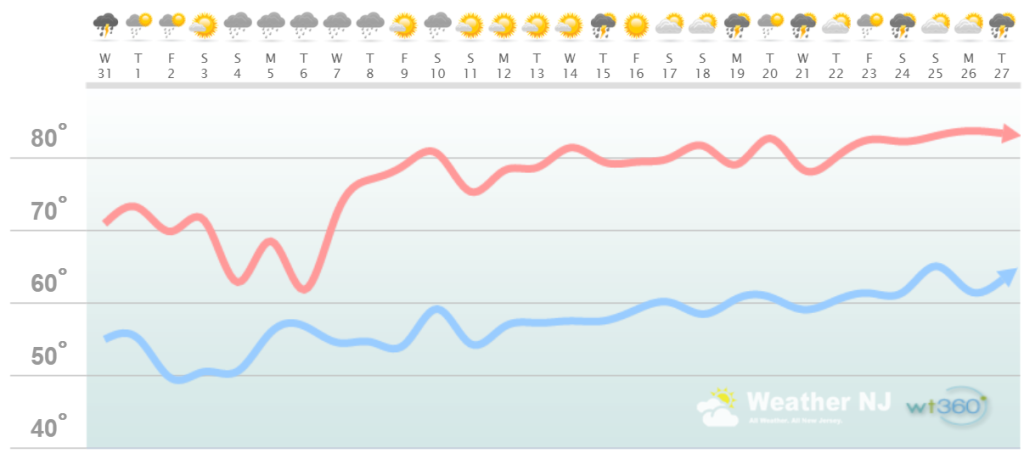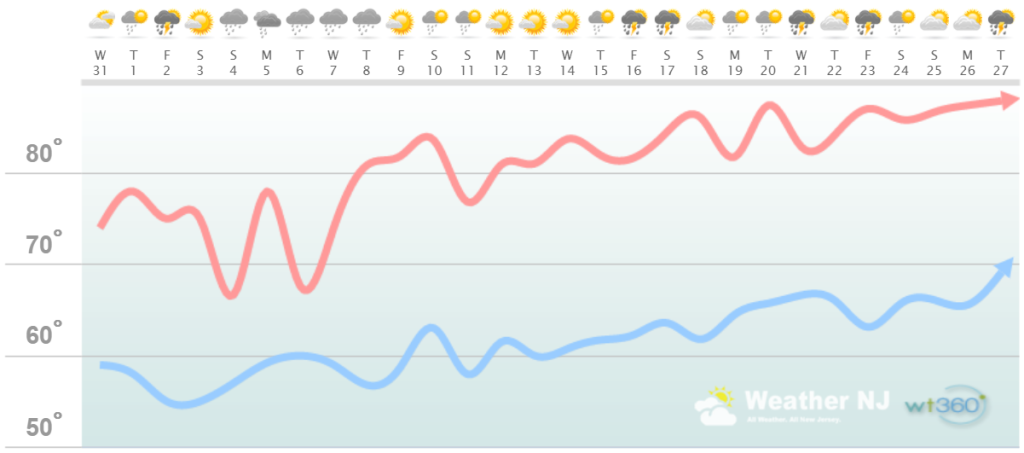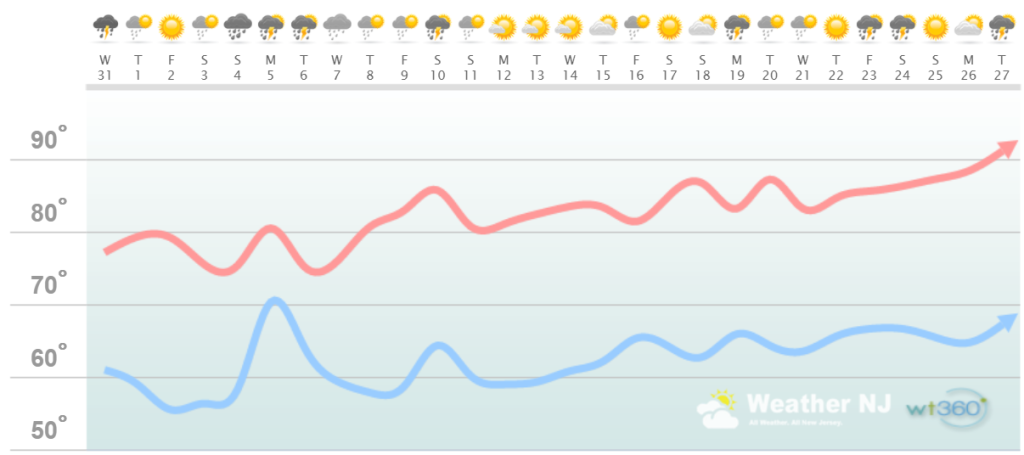June 2017 Discussion

It’s time to harness the WeatherTrends360 proprietary weather algorithms to see how June of 2017 should play out. But first lets break New Jersey into proper climatological regions. We have the higher elevations of NNJ/NWNJ, the interior coastal plain (SWNJ through CNJ and into NENJ – Newark Basin), and the coastal regions (most of SENJ coast – Sandy Hook down and around Cape May into Delaware Bay). I’ll be representing each climatological region with a 28-day graph from weathertrends360 data followed by a brief discussion.
Please keep in mind that these algorithms are documented with an 84% verification rate and are based on oceanic water cycles, time table series and very complex mathematics. The best takeaway from this data are general trends (cool vs warm, rainy vs dry, etc). I’m always hesitant to forecast specific surface conditions (rainfall amounts, snowfall amounts, winds, etc) beyond the 4-7 day forecasting period. But temperature and precipitation trends is what WeatherTrends360 does best with their proprietary mathematical analysis derived from over 150 years of reactive pattern data. For this reason, let’s call this a long-range discussion of expectations rather than a locked-in forecast.
Higher Elevations of NNJ/NWNJ
(Sussex, Warren, Hunterdon, Morris, N. Somerset, and N. Passaic) – Known for little to no Atlantic Ocean influence, colder-snowier winters, and drier conditions in general when compared to the coast. This rnown to get hot when high pressure sits overhead during the summer and bitterly cold during Arctic outbreaks in the winter. Elevation is a major influence that separates this micro-climate from the rest of New Jersey. This region extends into NE PA (Poconos) and parts of NY State (Catskills).
Higher Elevation Discussion: The current gloomy and cooler pattern looks to extend through the first third of June. After that, the pattern should switch to a warmer and drier setup with most precipitation occurring from frontal activity (thunderstorms, short-duration squalls, etc) rather than widespread synoptic rain systems. As you can see on the graph above, temperature trends should warm between June 6-10 as we endure the last of the rainy/cool pattern. The second two-thirds of June should feature temperatures hovering around 80 in general. Typically you should expect a few days to flirt with 90s but the most important thing is that temperatures should be seasonably average instead of the below-average conditions we’ve become used to. And for June, seasonably average is considered warm/hot.
Interior Coastal Plain from SWNJ-CNJ-NENJ
(Salem, Gloucester, Camden, W. Burlington, Mercer, W. Monmouth, Middlesex, S. Somerset, Union, Essex, Hudson, Bergen, and S. Passaic) – Known for naturally higher temperatures due to lower elevations away from the oceanic influence. This region is also known as “heat island” due to transportation (I-95 corridor), smog, abundant asphalt, concrete, and other man-made substances that naturally absorb and retain heat moreso than natural protected land. This is why excessive heat warnings and air quality alerts are more common in this region. SWNJ always tends to run a few degrees warmer than NENJ but this region is very similar otherwise in micro-climate due to the parallel nature of the Appalachian Mountain elevations to the NW. The same micro-climate can be extended into SE PA and NE MD which tends to run just a little stormier than NJ. This however is what makes up the interior coastal plain.
Interior Coastal Plain Discussion: The current gloomy and cooler pattern looks to extend through the first third of June. After that, the pattern should switch to a warmer and drier setup with most precipitation occurring from frontal activity (thunderstorms, short-duration squalls, etc) rather than widespread synoptic rain systems. As you can see on the graph above, temperature trends should warm between June 6-10 as we endure the last of the rainy/cool pattern. The second two-thirds of June should feature temperatures ranging in the 80s with 90+ days very much on the table. This region tends to reach the warmest temperatures on dry sunny days. The most important thing is that temperatures should be seasonably average instead of the below-average conditions we’ve become used to. And for June, seasonably average is considered warm/hot, especially in this region.
Coastal Regions of SENJ
(Cumberland, Cape May, Atlantic, E. Burlington, Ocean, and E. Monmouth) – Known for tremendous influence from the Atlantic Ocean. Oceanic influence keeps this zone cooler in the summer and warmer in the winter than the interior coastal plain and especially the higher elevations of NWNJ. In the summer, sea breeze fronts back into the coast and can ignite thunderstorms if enough instability is present. The cooler marine air slides under the hot air to the W and provides additional atmospheric lifting. This is both why it’s 5-15 degrees cooler at the shore than the Philly-Trenton area and why near-stationary thunderstorms can form along the coast capable of producing localized flash flooding. In the winter, the ocean is warmer than interior regions which plays a huge role in rain vs. snow—highly dependent on wind direction. When the winds chance from NE to N/NE, that’s usually when temps crash and change rain over to snow. Regardless, this micro-climate is well known, well documented and well expressed. This region extends into most of Delaware as well.
Coastal Region Discussion: The current gloomy and cooler pattern looks to extend through the first third of June. After that, the pattern should switch to a warmer and drier setup with most precipitation occurring from frontal activity (thunderstorms, short-duration squalls, etc) rather than widespread synoptic rain systems. As you can see on the graph above, temperature trends should warm between June 6-10 as we endure the last of the rainy/cool pattern. The second two-thirds of June should feature temperatures ranging in the 80s. This region struggles to break 90 along immediate coastal areas mostly due to ocean temperatures (in the lower-60s) buffering the lower-level air mass. A different planet from interior CNJ/SNJ. The good news is that 80s (70s for barrier islands/immediate coast) will feel amazing once we’re out of this funk.
Weathertrends360 is a complete, global, web solution to help retailers and suppliers capitalize on the weather and its influence on sales and marketing plans up to a year ahead. Learn how to become PROACTIVE vs REACTIVE with the weather in every phase of your business – how much inventory to buy/produce, where to allocate more/less, when to run weather-optimized advertising/marketing campaigns – weathertrends360 can help you determine all of this in minutes! 84% independently audited accuracy for both short-term and year-ahead forecasts for temperature and precipitation.
Discussion: The upper-levels have been relentless at keeping average to below-average heights over the Mid-Atlantic US. We can thank the blocking pattern for this as upper-level low/trough after upper-level low/trough continues to move through. The sun angle is almost at its annual highest (occurs on the solstice) which means strong solar radiation is making it to the surface. This, underneath the colder upper-levels, is a recipe for unsettled rainy/stormy conditions and likely the reason why it has been that way. Once we’re into mid-June (no sooner than the ~10th), average to above-average upper level heights should move into the region and stabilize the weather into what we know as “summery” conditions. Higher heights means convective suppression and capping inversions. This means we will likely take a break from synoptic rain systems and deal with frontal precipitation that comes with the Norwegian Cyclone Model between warm and cold fronts. That’s what I’m seeing for the second 2/3 to 1/2 of June as of right now.
In English: Overall, the month of June should start cool and wet (for a change right?) but transition to warmer and drier conditions June 12-forward. Hang in there everyone, it’s coming! As a side note, we’re leaving the nor’easter season and are about to move into hurricane season. The waters off the Mid-Atlantic are very cool still so we likely won’t see any tropical impact. However, we might see a few early-named storms form in the Atlantic Basin closer to the tropics. I’ll be paying close attention to it should anything form. Otherwise, we’ll probably be picking this conversation up in the July 2017 discussion. Everyone have a great June and please be safe! JC
Jonathan Carr (JC) is the founder and sole operator of Weather NJ, New Jersey’s largest independent weather reporting agency. Since 2010, Jonathan has provided weather safety discussion and forecasting services for New Jersey and surrounding areas through the web and social media. Originally branded as Severe NJ Weather (before 2014), Weather NJ is proud to bring you accurate and responsible forecast discussion ahead of high-stakes weather scenarios that impact this great garden state of ours. All Weather. All New Jersey.™ Be safe! JC












